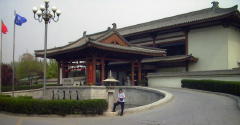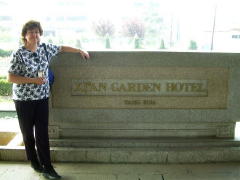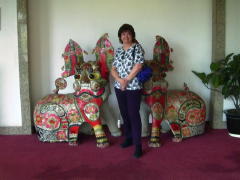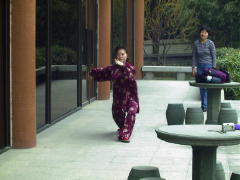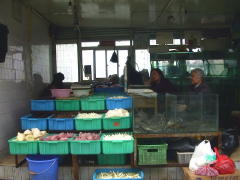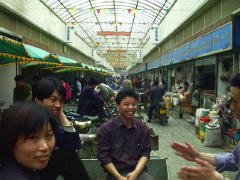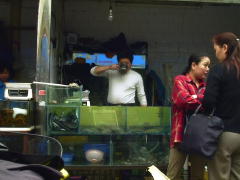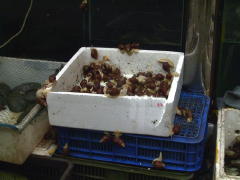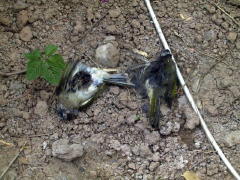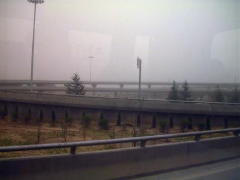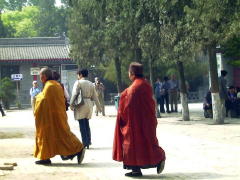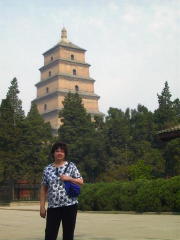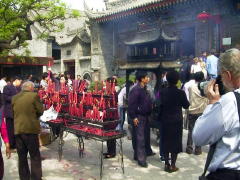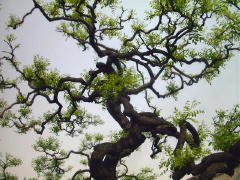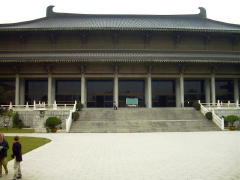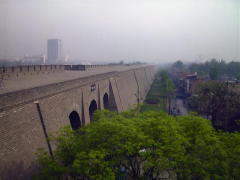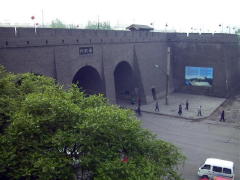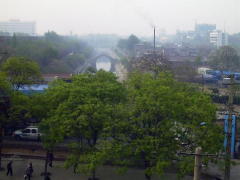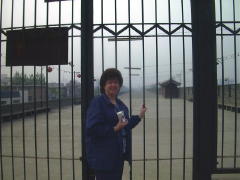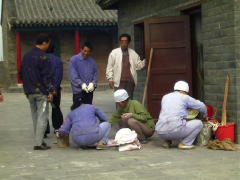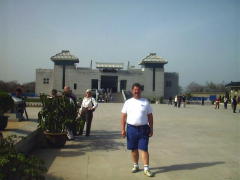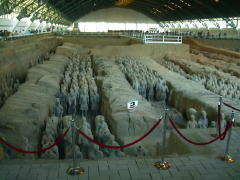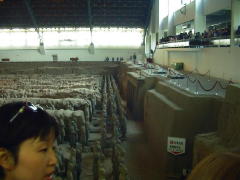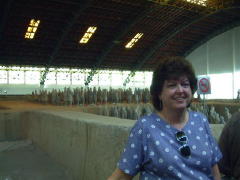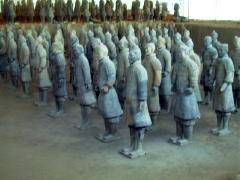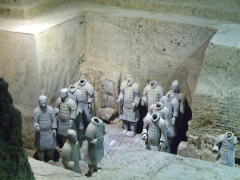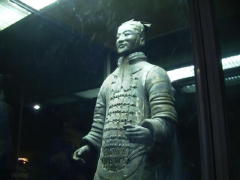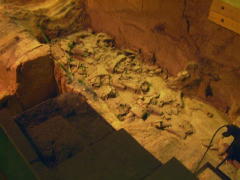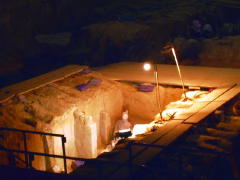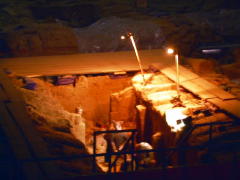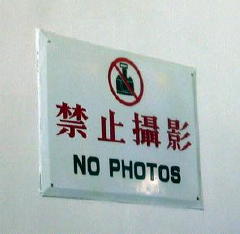|
April 16 - 18, 2000 |
Photos & Text © 2000 by Len Schwer
Revised 17 September 2000
|
(Daily Journal- Day 5) |
|
The overnight sleeper train from Beijing to Xian was not the most pleasant night's sleep of the trip. It was included by OAT to provide a 'special experience.' The beds were hard platforms and were provided with sleeping bag type bed clothes, that had not been washed since the previous use. The compartments have 4 berths, but OAT bought the whole compartment for each couple so we didn't have to share.
This is what's called a 'Soft Sleeper' or First Class in a society with classes; no one ventured to see what the 'Hard Sleeper' section was like. We were provided with box lunches before we left Beijing as apparently even the Chinese don't like the train food. The best part of the train ride was the brief AM and PM views of the wonderful countryside. The land near Beijing is fairly flat, but there were small rolling hills near Xian. Every inch of land is used, primarily for growing food. I was told China has 3 nuclear power plants, but I don't think this was one of the nuclear sites, as I saw no river to provide the cooling water. |
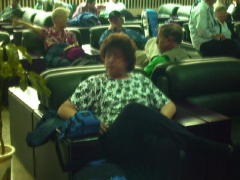 First Class lounge, Beijing Train Station |
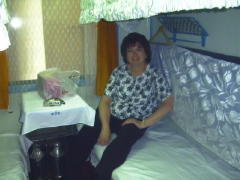 Soft Sleeper compartment |
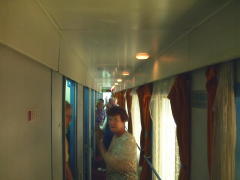 Looking down the train corridor |
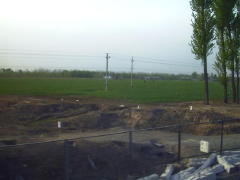 Typical train views near Beijing |
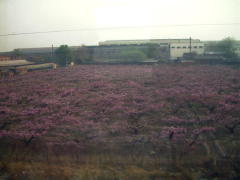 Plum orchard near Xian |
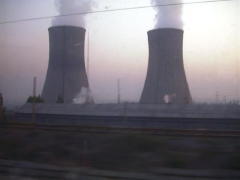 China needs lots of power |
|
(Daily Journal- Day 5) |
|
The Xian Garden Hotel overall was the nicest hotel we stayed in during our trip. The rooms were very nice and the hotel is located in a mostly residential neighborhood adjacent to the Big Wild Goose Pagoda. The hotel is a 'cooperative venture' with a Japanese company, which explains a lot about the attention to detail and service. Upon arrival we were treated to demonstration of Tai Chi, or 'morning exercises' that mostly the seniors practice every day in Chinese parks or handy open spaces.
One day we walked through a seafood and fish market in Xian. I would bet you can see and buy everything that moves below the surface of the ocean within these few blocks. Shortly after arriving in China I noticed a lack of birds in Beijing, i.e. no pigeons in Tiananmen Square. The guide said they had all gone south for the winter, but I think the nasty city air pollution has something to do with it. I spotted these two dead birds in the courtyard of our Xian hotel and wondered what had done them in? The afternoon we left Xian a dust storm blew into the city and limited visibility to less than a half KM. I was concerned that our flight to Chengdu might be delayed, but it was unaffected. I was told this was a bit late in the season for such a nasty dust storm; although Beijing had a severe several day long dust storm a few weeks before we arrived. |
|
(Daily Journal- Day 7) |
|
Adjacent to our hotel was the Big Wild Goose Pagoda (there is a small one too) which is a famous City landmark and popular tourist stop for many Buddhists. It was built to house the scrolls of a famous Chinese Buddha. Also next door was the Shaanxi Provincial Museum that features many paintings from the Tang Dynasty which is said to be a favorite period for most Chinese as it ushered in many modern Chinese practices.
The local government of Xian works to maintain the City's ancient heritage by limiting the types and heights of building that can be constructed inside the City Walls. The City's rectangular walls, and surrounding moat, are well maintained and a source of local pride; our China guide Linda is a resident of Xian and imparted a strong sense of civic pride in her hometown. The East gate we visited is touted as the start of the famous Silk Road that provided a trade route between China and the region to their west. These City wall and gate photos also show the very typical haze and smog that pervades all the Chinese cities we visited. Air pollution is a problem in China, but not ranked as important a problem as others. |
|
(Daily Journal- Day 5) |
|
The Shaanxi Grand Opera House is noted for two things: the cultural dance demonstrations, and their dumpling dinners. The dances, and colorful costumes, recreate those of the favorite Tang Dynasty era. The entertainment included musical solos on a type of horizontal harp that was beautiful and a spectacular flute solo.
The dumpling are served in typical Chinese steamers, but each type of dumpling filling is identified by the unique shape of the dumplings, most patterned after animals and some depicting the that dumpling's filling. The dinner show stopper is when the waiters bring a flaming soup container to each table. |
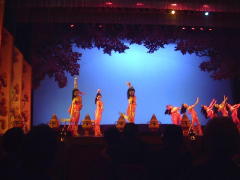 Lovely costumes |
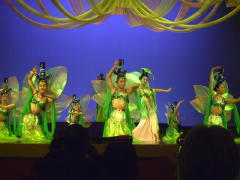 Lovely ladies |
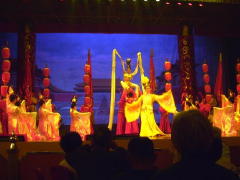 A beautiful dance demonstration |
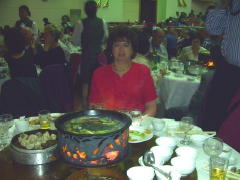 Flaming soup container was hot! |
|
(Daily Journal- Day 6) |
|
Now billed as the 8th Wonder of the World, the Terra Cotta Army of Xian was discovered by a farmer digging a new well in 1974. Over 6000 figures guard the tomb of Qin Shi Huangdi who built the Great Wall and unified China.
This site has placed Xian on-the-map as a tourist Mecca for both Chinese and foreign tourists. Although the emphasis is clearly on foreign tourist as witnessed by the English only site introduction movie shown in a 360 degree surround theater. I was frankly embarrassed by the English only narration. Imaging going to the Grand Canyon and watching a movie in the visitor center that was only in Mandarin! The large number of tourists, and distance they are kept from the figures, was disappointing; tourists are hauled overland, 4 hours in buses, from cruise ships. My apparent close up photos I took with a zoom, and many were blurred because of camera motion. The security guards make no effort to enforce the ban on photos. |
Photos & Text © 2000 by Len Schwer
